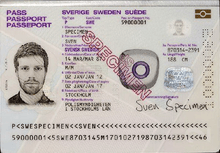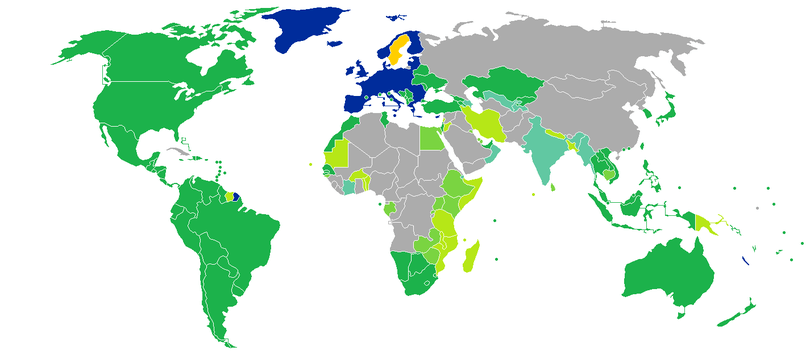Swedish passport
| Swedish passport | |
|---|---|
| Date first issued | 2 January 2012 (current version) |
| Issued by |
|
| Type of document | Passport |
| Purpose | Identification |
| Eligibility requirements | Swedish citizenship |
| Expiration | 5 years after issuance for individuals aged 12 and above; 3 years for citizens 11 and under. |
| Cost | 350 SEK[1] (1400 at embassies)[2] |
Swedish passports are issued to nationals of Sweden for the purpose of international travel. Besides serving as proof of Swedish citizenship, they facilitate the process of securing assistance from Swedish consular officials abroad or other European Union member states in case a Swedish consular is absent, if needed (every Swedish citizen is also a citizen of the European Union).
An ordinary Swedish passport allows for free rights of movement and residence in the EEA and Switzerland, and short-term visits without arranging a visa in advance to 187 countries which ranks the Swedish passport 3rd in the World as of May 2018.
Swedish passports are issued by the Swedish Police and applications are filed at police stations equipped with a passport terminal for taking photographs and fingerprints. Passports issued since 1 October 2005 are biometric, and valid for five years.[3] Earlier passports are valid for ten years (adults) or five years (children). The blue cover passports issued up until 1998 (and not valid after 2008) are not valid as identity documents in Sweden due to insufficient security features which resulted in widespread forgery.
It is possible for a Swedish citizen to hold two valid passports at the same time if it is needed for work or "other special reason" [4] The validity time of an additional passport is "as long as the necessity applies",[5] but never longer than the ordinary passport. This can be useful when travelling to states which reject a passport with an entry stamp or visa of another state in it (Israel vs several Arab states). Also it is useful when one needs to travel when the ordinary passport is handed in for a visa application.
In 2013, Swedish passports were reported to be among the most frequently sold passports on the black market. The reason cited was that there was no upper limit on the number of replacement passports being issued to the rightful holder. This prompted calls for legislation to limit the number of times replacement passports could be issued to each Swede.[6] On 15 April 2016 a new law was enacted so that no more than three passports could be issued to the same Swede within a five-year period.[7]
Physical appearance and data contained

The Swedish passports issued since 1 October 2005 are burgundy, with the words "EUROPEISKA UNIONEN" (EUROPEAN UNION), "SVERIGE" (SWEDEN) and "PASS" (PASSPORT) inscribed at the top of the front cover, and the Swedish lesser coat of arms emblazoned on the bottom of the front cover. The Swedish passport has the standard biometric symbol emblazoned below the coat of arms and uses the standard European Union design. Diplomatic passports are dark blue, with the words "DIPLOMATPASS" (DIPLOMATIC PASSPORT) and "SVERIGE" (SWEDEN)
Identity information page
The Swedish Passport includes the following printed data:[8]
- Photo of Passport Holder
- Type (P)
- Code (SWE)
- Passport No.
- 1 Surname
- 2 Given Names
- 3 Nationality (SVENSK SWEDISH)
- 3a. Personal Id. No.
- 4 Date of Birth
- 4a. Height
- 5 Sex
- 6 Date of Issue
- 7 Date of Expiry
- 8 Place of Birth
- 9 Authority
- 10 Holder's Signature
The information page ends with the Machine Readable Zone starting with P<SWE. In addition to this, the passport also has printed safeguards to make it easier to visually detect forgery attempts.
Different spellings of the same name
Personal names containing special letters (for example, å, ä, ö) are spelled the correct way in the non-machine-readable zone, but are mapped in the machine-readable zone, å becoming AA, ä becoming AE, and ö becoming OE. For example: Fältskog → FAELTSKOG.
Letters with accents are replaced by simple letters (for example, é → E).
Chip data
The new chip based passports contain an RFID chip with 16 data groups (DGs).
- DG1 – MRZ, mandatory
- DG2 – Face, mandatory
- DG3 – Finger, optional (Mandatory for EU Schengen and EU MS)
- DG4 – Iris, optional
- —
- DG14 – SecurityInfo, optional
- DG15 – Active authentication public key, optional
- SO – Security object, mandatory
The security object contains signed hash values of all data groups. Correctly verifying this SOD with its PKI certificate hierarchy will tell that the passport is authentic and issued by the correct and valid issuer. Even the public available data (DG1, DG2, DG14, DG15, SO) in the chip requires a simple authentication for access based on what is printed on the passport itself. This is to protect against unauthorised access and eavesdropping.[8] The European Union requires fingerprint data to be stored in the member state's passports chip at latest in June 2009. Sweden started storing fingerprint data when applying for a new passport on 28 June 2009.
Languages
The data page/information page is printed in Swedish and English, with translation in other official languages of the European Union elsewhere in the document. The page containing the guide to check the security features of the data page is printed only in English.
Identification requirements
Application is done at special passport offices or embassies. The applicant must show up in person, and will have the photo taken there. When doing the application identification of the applicant is needed. This is done by:[9]
- Showing a valid Swedish passport (not temporary), Swedish national id card, Swedish driver's license, Swedish tax office id card, or an id card following the SIS standard.
A person not possessing any of these identity documents must bring a person who vouches for the identity, is at least 18 years old, has one of the above documents, and is one of:
- Husband, wife, someone living at the same address, parent, grandparent, own child, sibling, adopted parent or equivalent, employer since at least one year, or an official at an authority who knows the person through their work.
These requirements are similar to the procedure for other Swedish identity documents. There is no age limit to get a passport, but people below 18 must be accompanied by their guardian (preferably both) at application.
Visa free travel

Visa requirements for Swedish citizens are administrative entry restrictions by the authorities of other states placed on citizens of Sweden. In May 2018, Swedish citizens had visa-free or visa on arrival access to 187 countries and territories, ranking the Swedish passport third in the world (tied with Finnish, French, Italian, South Korean and Spanish passports) according to the Visa Restrictions Index.[10]
Abuse & black market trade of Swedish passports
Before 2016, Sweden had no limit on the number of times an individual may claim to have lost a passport and have a new one re-issued. That led to Swedish passports being sold on the black market and used by people smugglers.[11] This prompted calls for legislation to limit the number of times replacement passports could be issued to each Swede.[6] On 15 April 2016 a new law was enacted limiting holders to a maximum of three passports issued within a five-year period.[7]
| Number of passport issued to individual | Number of such individuals |
|---|---|
| 3 | 20 162 |
| 4 | 4 884 |
| 5 | 998 |
| 6 | 291 |
| 7 | 96 |
| 8 | 33 |
| 9 | 14 |
| 10 | 2 |
| 11 | 3 |
| 12 | 3 |
| 18 | 1 |
See also
References
- ↑ Pass och nationellt id-kort
- ↑ Passport/Register child
- ↑ "Fakta om nya passet". Swedish Police Authority. Archived from the original on 1 April 2010. Retrieved 17 May 2010.
- ↑ "Passförodning (1979:664)" (in Swedish). Retrieved 25 February 2012.
- ↑ "Passförodning (1979:664)" (in Swedish). Retrieved 25 February 2012.
- 1 2 Olaglig handel med svenska pass ökar, from Dagens Nyheter, accessed 29 September 2013
- 1 2 New rules to reduce abuse of Swedish passports, from Government of Sweden, accessed 15 April 2016
- ↑ http://www.consilium.europa.eu/prado/EN/1292/viewImage_28112.html
- ↑ "Giltig legitimation vid ansökan av pass". polisen.se (in Swedish).
- ↑ https://www.henleyglobal.com/files/download/HPI2018/PI%202018%20INFOGRAPHS%20GLOBAL%20180518.pdf
- 1 2 (sv) Missbruk av svenska pass Omfattning och åtgärdsförslag Ds 2015:12. Ministry of Justice (Sweden). 30 April 2015. p. 71. ISBN 978-91-38-24246-9. Retrieved 19 February 2017.